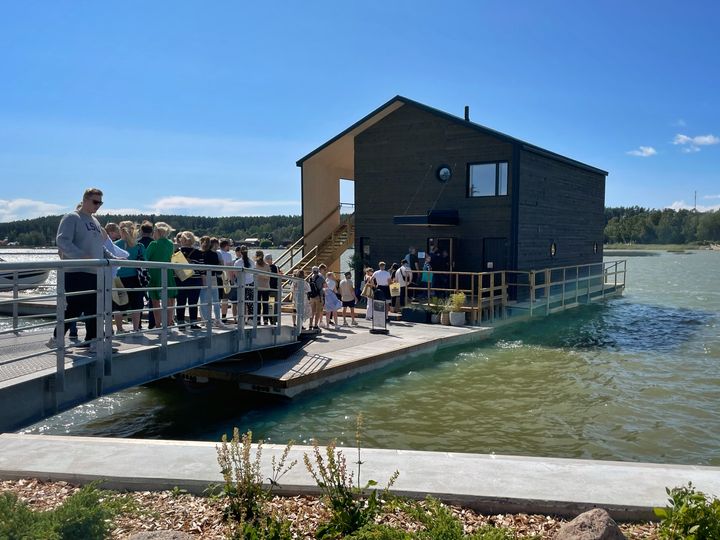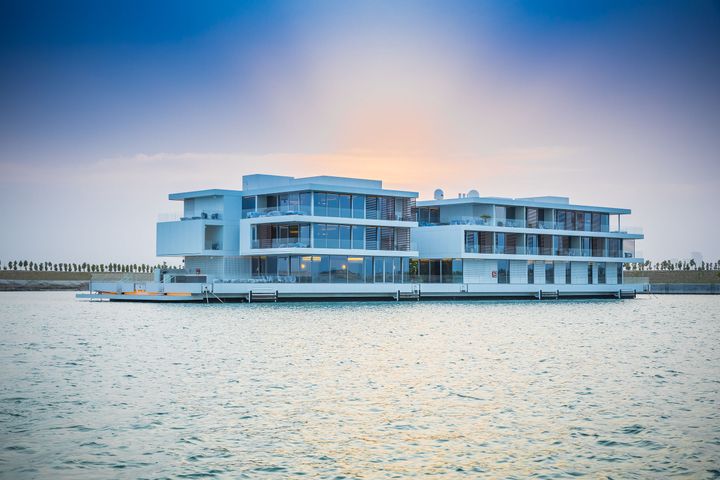Expert study: Finnish know-how in building floating houses is of interest around the world – in Finland, the industry is held back by the lack of guidelines
Floating housing construction in Finland has remained at the level of individual experiments, even though Finnish floating construction know-how is already being used as an export product in the world. The expert report commissioned by Finland’s Housing Fair describes what kind of opportunities and challenges there are for floating residential construction in Finland. According to the report, in order for floating construction to become common in Finland, it needs guidelines and more extensive experiments.

One of the objectives of the cooperative Finland’s Housing Fair is to act as an experiment and development platform for new ways of living and building. "We wanted to commission an objective expert report to increase Finns' understanding of the opportunities and challenges associated with floating construction," says Anna Tapio, CEO of Finland’s Housing Fair.
Until 6th August, the public will be able to get to know Finland's first year-round floating house at the housing fair in the marine town of Loviisa. The extraordinary home is of interest to the public, because even though there are floating housing projects underway in several Finnish cities, they progress slowly.
According to the study carried out by Sweco, Europe´s leading engineering and architecture consultancy, Finland has a strong know-how and technology base for floating housing construction thanks to centuries of ship and boat building history. Floating housing construction is already a Finnish export product, examples of which can be seen around the world, but the domestic experiences are few compared to, for example, Sweden or the Netherlands. Finland also has the natural conditions for floating living, as Finland has the most waterways in the world, with 56,000 lakes over a hectare in size, 38,800 km of riverbeds over five meters wide, and 46,200 kilometers of coastline.
There are solutions for the special requirements of floating construction
Sweco´s Senior Advisor Lasse Rajala, who was the main author behind the study, believes that floating construction is an ecological solution to many challenges. "In Finland, the driving factors for floating construction can be seen as the high prices of waterfront plots in cities, the challenges posed by safe building heights and additional costs in coastal regions, the possibility of dense and low-lying urban area development, and a method of construction that does not disturb the environment and is ecological and adaptable."
The residential part of a floating building is mostly quite conventional construction, but buoyancy and portability bring with it a number of new features that do not occur in traditional construction on land and which often raise questions. According to the report, permanent floating construction requires special solutions regarding, among other things, zoning and land/water area ownership, building and structural engineering, housing safety and building maintenance.
Although there are solutions that work in principle for all 15 special aspects listed in the report, the awareness and experience of solutions found to be good have not been purposefully gathered together in Finland - probably precisely because the floating form of housing does not occur in practice in Finland.

The report recommends compiling centralized national guidelines
As a follow-up measure, the report proposes the preparation of a centralized national guideline to support all parties involved in floating residential construction projects. There is plenty of information and guidance related to floating housing available, but the information is quite fragmented. The national-level, universal guidelines compiled for domestic conditions would serve as a guideline for planning, building control, rescue operations, planning and construction, and where applicable, also support for exports.
As another concrete follow-up measure, the report proposes the construction of a small or small floating housing communities alongside the individual floating test houses, in order to gain more experiences of floating living in its characteristic form. It is also worth paying attention to the attractiveness of floating projects.
The report says that according to current estimates, in the second half of this century, hundreds of millions of inhabitants of the world's coastal cities will have to find other places to live due to floods caused by rising sea levels. "The know-how to build floating residential buildings and floating blocks could offer Finland considerable international export opportunities. Learning from domestic experiences could strengthen the credibility and know-how needed to increase exports," says Anna Tapio.
Tens of thousands of fair visitors have already gotten to know the floating house “Talo Lovisea”
Tens of thousands of fair visitors have already come to admire the 113-square-meter floating house “Talo Lovisea”, which can be seen at the housing fair in Loviisa. According to Janine Henriksson-Wiberg, representing Loviisa Kelluva Kuningatar Oy, which built the house, the visitor feedback can be summed up in the word "Wow".
Adult guests have especially admired the floating home's wonderful views, space and fragrance. Many have also inquired whether the house sways. "I usually answer this by saying that in the first week of July, when the wind was blowing 23 meters per second, I saw a little movement in the lamp, but nothing more," says Henriksson-Wiberg.
"The most unreserved response to the floating house has been from the child visitors. Countless of the youngest in the family have already announced their clear desire to move into the house in the hallway."
More information:
"Floating living in Finland - what could it be?" - expert report in full (Finnish only)
Summary of the report (Finnish only)
Senior Advisor Lasse Rajala, Sweco, tel. +358 50 563 5882 / lasse.rajala@sweco.fi
Chair Janine Henriksson-Wiberg, Loviisan Kelluva Kuningatar Oy, tel. +358 50 308 1801 / janine.henriksson@he-wi.fi
CEO Anna Tapio, Cooperative Finland’s Housing Fair, tel. +358 40 717 1051 / anna.tapio@asuntomessut.fi
The floating home, Talo Lovisea, designed for year-round living, can be visited at Loviisa's Kuningattarenranta housing fair area until 6th August.
Alternative languages
Subscribe to releases from Asuntomessut
Subscribe to all the latest releases from Asuntomessut by registering your e-mail address below. You can unsubscribe at any time.
Latest releases from Asuntomessut
Moderni kyläsauna kellumaan Oulujoen suistoon3.7.2025 08:42:00 EEST | Tiedote
Asuntomessut Oulussa esittelee messukotien ohella myös Oulujoen rannassa kelluvan Olosaunan. Se yhdistää modernin arkkitehtuurin, perinteisen saunakulttuurin ja huippuluokan suomalaisen puurakentamisen ainutlaatuiseksi moniaistilliseksi kokemukseksi.
Asumisen ihanteet todeksi Hartaanselänrannassa28.5.2025 13:56:59 EEST | Artikkeli
Suomen Asuntomessujen teettämän Asumisen ihanteet -tutkimuksen mukaan suomalaiset haluavat asua rauhallisella alueella lähellä luontoa, mieluiten omakotitalossa, mutta kaupungin palveluiden läheisyydessä. Tänä kesänä Asuntomessuilla Oulun Hartaanselänrannassa monet toiveet ja ihanteet toteutuvat.
Asuntomessut 2028 etenevät: Salo tuo uuden messukonseptin keskustaan26.5.2025 18:35:56 EEST | Tiedote
Asuntomessuhanke Salossa on edennyt seuraavaan vaiheeseen: Osuuskunta Suomen Asuntomessut ja Salon kaupunki siirtyvät nyt alustavista neuvotteluista suunnitteluun. Salo toimii pilottikaupunkina täysin uudenlaiselle messukonseptille, jossa messukohteet sijaitsevat usealla eri alueella ja sulautuvat osaksi kaupunkirakennetta.
Asuntomessujen pysäköintijärjestelyjä suunnitellaan yhteistyössä Pickalassa26.5.2025 15:35:29 EEST | Tiedote
Pickala Rock Resortin kaava-alueelle Siuntion Störsvikiin on suunnitteilla Asuntomessut kesällä 2027. Asuntomessut on yksi Suomen suurimpia kesätapahtumia, johon odotetaan kuukauden aikana yhteensä yli 100 000 kävijää.
Asuntomessujen uudet kohteet esittelevät lupavapaita rakennuksia ja innovatiivisen palvelukorttelin16.4.2025 09:26:31 EEST | Tiedote
Kesän 2025 Asuntomessut Oulussa esittelevät uusien pientalojen lisäksi joukon vapaa-ajan kohteita ja modernia kerrostaloasumista. Uusia kohteita Asuntomessuilla ovat rakennuslupavapaat hirsirakennukset ja täysin valmiina toimitettavat saunat ja mökit. Kokonaan uudenlaista asumista edustaa Oulun Toppilansalmen satama-alueelle nouseva yhteisöllinen Satamatien palvelukortteli.
In our pressroom you can read all our latest releases, find our press contacts, images, documents and other relevant information about us.
Visit our pressroom